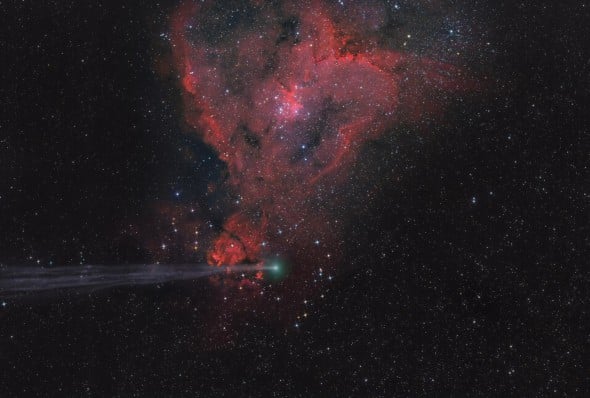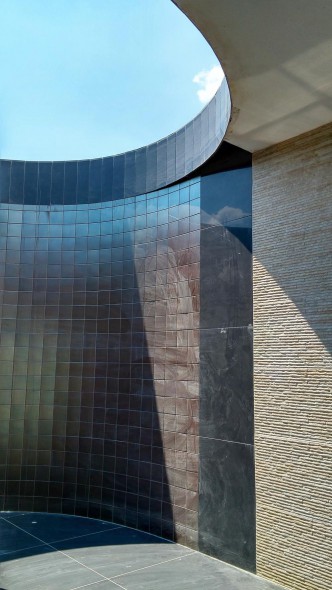Lefteris Velissaratos won deserved accolades in Astronomy Photographer of the Year for an image showing a comet passing through the heart of a nebula. We catch up with him to find out more …

Image by Lefteris Velissaratos
Don’t let the tranquil night sky fool you – deep space is full of drama, and a few well-engineered lenses are all you need to enjoy the show.
Case in point: Lefteris Velissaratos’ fabulous image “The Arrow Missed the Heart”, showing a comet soaring into what looks like the beating heart of a nebula. The judges of Astronomy Photographer of the Year agreed, awarding Lefteris first place in the “Planets, Comets and Asteroids” category.
‘A tough picture to do well because the comet moves relative to the background nebula,’ said competition judge Pete Lawrence, British amateur astronomer and BBC Sky at Night alumnus. ‘Some great structure is visible in the comet’s tail and there’s a lovely colour contrast between the red nebula and the comet’s head.’
A keen astronomer, Lefteris is actually building his own observatory in Greece, from which he captured this image! It was a pleasure to be able to chat to Lefteris to find out more about his image and his work…
On planning and executing the image
“While I’ve been making images of deep-space objects for some time, I hadn’t made any images of a comet since C/2014 E2. For this one I didn’t want to just capture a comet sailing in a star field – I wanted a different composition, more than just a lonely visitor passing a background of stars.”
“The project I came up with was to have the path of the comet’s ‘arrow’ meeting with NGC896, also known as the ‘Heart Nebula’. I captured the image on the 10th of August, 2014 from my observatory in Korinthia, Greece.”
“For this image I used a wide field refractor FSQ106 ED telescope, with excellent corrected optics, without color aberrations in its 88mm image circle, in combination with the full-frame sensor of a SBIG STL11000 CCD camera. The imaging time was a total of one hour and 35 minutes of data through LRGB and Ha filters.”
On astrophotography
“I know the term ‘astrophotography’ is something that everyone understands, but to me it wrongfully implies a ‘snap-shot’ approach to making the final image. I think it would be ideal for people not familiar with astro-imaging to instead picture a process of ‘building’ an image, synthesising data from different wavelengths. It may be complicated, but we should see it as unlocking the ability to create images with endless possibilities.”
“What inspires me? Well… I could write a book about that. My immediate answer is that the idea of capturing ancient, distant light from all these endless worlds is like a never-ending spectacular journey for me.”
On placing in the Astronomy Photographer of the Year Competition
“What is important about the ‘Astronomy Photographer of the Year’ competition is not coming in first place, it’s the fact that so many amateur astronomers all around the world continually surpass themselves creating all these spectacular images.”
“It was a great feeling for me, and a unique experience to be among so many talented people.”
On building his own observatory
“The observatory is still in the construction stage. Everything is my design (after all, I’m a designer!), but I also have the valuable help of some unique friends, experts in their fields like aerospace and engineering, as well as very experienced amateur astronomers and technicians who have been approving and optimising my thoughts and designs. I can tell you that everything will be solar-powered, but cannot unveil any more at the moment (not even the name!) before the opening next year.”

A glimpse at Lefteris’ observatory
The gear
For this image Lefteris used an FSQ106 f/5 telescope, an EQ8 mount, a specialist STL 11000M camera, and a 530mm lens.
See more winners from Insight Astronomy Photographer of the Year 2015

